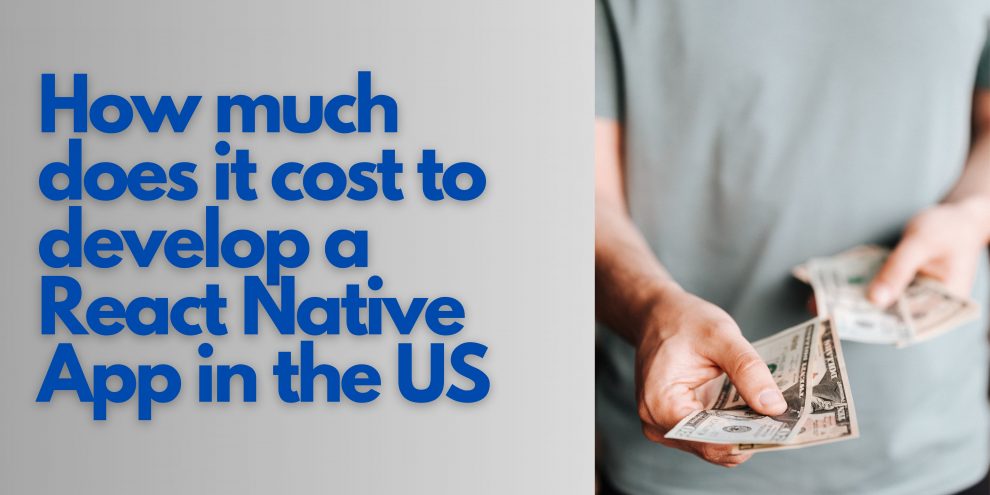In today’s rapidly evolving digital landscape, mobile applications have become an integral part of our daily lives. React Native, a popular framework for building cross-platform mobile apps, has gained traction among developers for its efficiency and cost-effectiveness. However, determining the cost of developing a React Native app in the US in 2023 can be a complex task, influenced by various factors. In this blog post, we will break down the key considerations that affect the cost of app development in the United States.
Factors Influencing the Cost
Several factors come into play when estimating the cost of developing a React Native app in the US. These factors include:
App Complexity:
- The complexity of your app’s features, functionality, and user interface design significantly impacts the cost. Simple apps will be more cost-effective than complex ones.
Development Team:
- Hiring experienced developers and designers in the US comes at a premium. The size and expertise of your development team can affect costs.
App Platform:
- Deciding whether your app will be developed for iOS, Android, or both platforms will impact the cost. Cross-platform development with React Native is generally more cost-effective than separate native app development.
Design and User Experience:
- Investing in a compelling and user-friendly design can increase costs but also enhance the app’s appeal and user retention.
App Maintenance:
- Post-launch maintenance and updates are ongoing costs that should be factored into your budget.
Cost Ranges
Determining the cost of your React Native app’s development involves understanding the specific features and complexity of your project. Here’s a more comprehensive breakdown of cost ranges for different types of apps:
Simple Apps: $10,000 – $50,000
- These are typically basic utility or informational apps with limited features. They may have a straightforward user interface and minimal custom functionality. Development time and cost are relatively low.
Moderate Complexity Apps: $50,000 – $150,000
- Apps falling into this category have more features and customization. They might include user authentication, database integration, and more sophisticated designs. Development time and costs increase due to added complexity.
Complex Apps: $150,000 – $500,000+
- Complex apps encompass large-scale projects with advanced functionality, extensive custom features, and intricate designs. Examples include social networking apps, e-commerce platforms, or on-demand service apps. Costs rise significantly because of the extended development timeline and the need for specialized skills.
It’s important to note that these cost ranges can vary depending on factors like geographic location, the level of expertise of your development team, and the scale of the project.
Hidden Costs
Beyond the initial budget, hidden costs can catch app owners by surprise. Here are some common hidden expenses to consider:
App Testing and Quality Assurance:
- Rigorous testing is essential to identify and fix bugs and ensure a smooth user experience. This phase may require additional resources and time.
Third-party Integrations:
- If your app relies on external services or APIs, you may need to pay licensing fees or cover usage costs. These can accumulate over time.
Hosting and Cloud Services:
- Hosting your app and its data on servers or cloud platforms involves ongoing expenses. Costs depend on factors like server capacity and data storage needs.
App Store Fees:
- When you publish your app on app stores like Apple App Store or Google Play Store, you’ll encounter registration fees and potentially recurring subscription fees.
Security and Compliance:
- Meeting security standards and regulatory requirements may necessitate additional investments in data protection and compliance measures.
Scaling and Updates:
- As your user base grows, you may need to scale your infrastructure and invest in continuous updates and improvements to meet user demands.
Hiring Options
Choosing the right development team is a critical decision in app development. Here’s a more in-depth look at your hiring options:
In-house Team:
Building an in-house development team provides complete control and immediate communication. However, it’s usually the most expensive option due to salaries, benefits, and infrastructure costs. This is best suited for large enterprises with ongoing app development needs.Outsourcing:
Outsourcing to a development agency or freelancers can be cost-effective and flexible. It allows you to tap into specialized expertise without the overhead of full-time employees. However, managing remote teams requires effective communication and project management skills.Hybrid Approach:
A hybrid approach involves a mix of in-house and outsourced talent. This provides a balance between control and cost-efficiency. You can manage core functions in-house while outsourcing specific tasks or skills when needed.
Selecting the right hiring option depends on your project’s size, complexity, timeline, and budget. Each approach has its advantages and trade-offs, so consider your priorities and resources when making this decision.
Learn More: How to Become a React Native Developer in the USA
Conclusion
Estimating the cost of developing a React Native app in the US in 2023 involves analysing numerous project-specific factors. These include app complexity, development team choice, platform selection, design considerations, and ongoing maintenance.
To ensure a successful project, it’s advisable to collaborate with experts in React Native, such as GeekyAnts, renowned for their proficiency in the framework. App development costs can vary significantly, informed decision-making, thorough planning, and budgeting are essential. Teaming up with experienced professionals like GeekyAnts can help you navigate these complexities and bring your app idea to life efficiently in the competitive mobile app landscape of 2023.

























